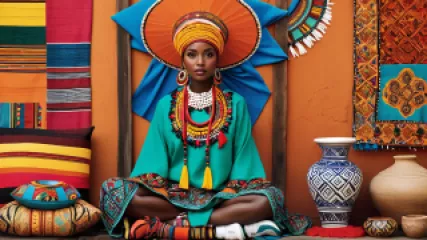The Ultimate Guide to Exploring and Embracing Your Cultural Identity
The Ultimate Guide to Exploring and Embracing Your Cultural Identity
Discovering and embracing one's cultural identity is a deeply personal and transformative journey. Our cultural roots shape who we are, how we view the world, and the values we hold dear. Yet, in our increasingly globalized and interconnected society, many individuals struggle to navigate the complex landscape of their cultural heritage. This ultimate guide is designed to empower you to embark on a meaningful exploration of your cultural identity, foster a deeper understanding of yourself, and cultivate a profound sense of belonging.
Understanding the Significance of Cultural Identity
Your cultural identity is the foundation upon which you build your sense of self. It encompasses the traditions, beliefs, customs, and worldviews that have been passed down through generations, shaping your perspective and guiding your interactions with the world around you. Embracing your cultural identity is not merely about preserving the past; it is a vital step in understanding your place in the present and charting a course for the future.
When you engage in the process of exploring your cultural identity, you unlock a deeper understanding of your roots, your values, and your unique role in the tapestry of humanity. This exploration can be a profound and empowering experience, allowing you to connect with your heritage, develop a stronger sense of self, and cultivate a greater appreciation for the diversity that enriches our global community.
The Benefits of Exploring Your Cultural Identity
Embarking on the journey of cultural identity exploration can have a transformative impact on various aspects of your life. By delving into the richness of your heritage, you can:
- Enhance self-awareness and gain a deeper understanding of your personality, beliefs, and the factors that have shaped your worldview.
- Strengthen your sense of belonging and connection to your community, both local and global, fostering a greater sense of purpose and fulfillment.
- Develop a greater appreciation for diversity and a more inclusive perspective, which can improve your relationships, communication, and overall well-being.
- Cultivate a stronger sense of resilience and the ability to navigate challenging experiences, drawing strength from the wisdom and experiences of your cultural ancestors.
- Inspire personal growth and transformation as you embrace your cultural identity and integrate it into your daily life.
By embracing the richness of your cultural heritage, you can unlock a profound sense of personal empowerment and belonging, paving the way for a more fulfilling and meaningful life.
Navigating the Complexities of Cultural Identity
Exploring your cultural identity can be a complex and nuanced process, as it involves navigating the intersection of individual experiences, family histories, and societal influences. It is essential to approach this journey with an open mind, a willingness to explore, and a deep respect for the diverse perspectives that shape the human experience.
One of the key challenges in exploring cultural identity is the potential for conflicting or overlapping identities. Many individuals, especially those with multi-cultural backgrounds, may find themselves grappling with the question of which cultural influences to prioritize or how to reconcile the different facets of their heritage. This can be a delicate and emotionally charged process, requiring patience, self-reflection, and a holistic understanding of one's unique cultural tapestry.
Furthermore, the process of cultural identity exploration can be influenced by various external factors, such as geographic location, socioeconomic status, and experiences of marginalization or discrimination. It is crucial to acknowledge and address these contextual factors, as they can significantly shape an individual's understanding and expression of their cultural identity.
Embarking on the Journey of Cultural Identity Exploration
Exploring your cultural identity is a deeply personal and multifaceted journey, and there is no one-size-fits-all approach. However, there are several key steps and strategies that can guide you along the way:
Step 1: Reflect on Your Family History and Lineage
Begin by delving into your family history and lineage. Engage in conversations with your elders, ancestors, and family members to uncover the rich tapestry of your cultural heritage. Ask questions about your family's traditions, customs, values, and experiences, and document the stories and perspectives you uncover.
If possible, explore your family's geographic origins, migration patterns, and significant life events that have shaped your cultural identity. This information can provide valuable insights into the broader historical and social contexts that have influenced your heritage.
Step 2: Immerse Yourself in Cultural Practices and Traditions
Actively engage in the cultural practices and traditions that resonate with you. This may involve participating in cultural celebrations, learning traditional crafts or cuisine, or exploring the art, music, and literature of your heritage. By immersing yourself in these cultural touchstones, you can develop a deeper understanding and appreciation for your roots.
Consider seeking out community organizations, cultural centers, or educational resources that can provide guidance and support in your exploration of cultural practices and traditions. These interactions can also help you connect with others who share your cultural background, fostering a sense of community and belonging.
Step 3: Engage in Self-Reflection and Identity Exploration
As you delve into your cultural heritage, make time for self-reflection and introspection. Examine how your cultural identity has shaped your worldview, values, and life experiences. Explore the ways in which your cultural background has influenced your personal growth, relationships, and decision-making processes.
This self-exploration may involve journaling, meditation, or engaging in meaningful discussions with trusted individuals. By taking the time to process and integrate your cultural identity, you can develop a more holistic understanding of yourself and your place in the world.
Step 4: Embrace the Fluidity of Cultural Identity
It is important to recognize that cultural identity is not a static or fixed concept. Rather, it is a dynamic and ever-evolving process that is influenced by various personal, social, and historical factors. As you navigate your cultural identity journey, be open to the fluidity and adaptability of your own cultural expression.
Embrace the idea that your cultural identity can shift and evolve over time, and be willing to incorporate new influences and experiences into your understanding of self. This flexibility and adaptability can help you navigate the complexities of cultural identity and foster a deeper sense of personal growth and self-acceptance.
Step 5: Cultivate Intercultural Competence
As you deepen your understanding of your own cultural identity, make a concerted effort to also learn about and engage with the cultural backgrounds of others. Develop an appreciation for the diversity of human experiences and perspectives, and seek to bridge cultural gaps through open-minded dialogue and cross-cultural collaboration.
Cultivating intercultural competence can enhance your ability to communicate effectively, build meaningful relationships, and navigate the increasingly globalized world. By embracing cultural diversity and fostering cross-cultural understanding, you can contribute to a more inclusive and harmonious society.
Overcoming Challenges and Embracing Your Cultural Identity
Exploring and embracing your cultural identity can be a deeply rewarding, yet at times, challenging journey. You may encounter obstacles such as intergenerational conflicts, the loss of cultural traditions, or feelings of marginalization and disconnection. It is important to acknowledge these challenges and to develop strategies for navigating them.
Navigating Intergenerational Conflicts
Differences in cultural perspectives and values between generations can sometimes lead to conflicts and misunderstandings. Approach these situations with empathy, open communication, and a willingness to find common ground. Engage in respectful dialogues to understand the lived experiences and perspectives of both older and younger generations, and work collaboratively to bridge the gaps.
"The greatest gift we can give our children is to allow them to honor their cultural identity, while also empowering them to forge their own path in the world." - Mariah Taylor
Preserving and Revitalizing Cultural Traditions
In an increasingly globalized world, the preservation and revitalization of cultural traditions can be a challenging task. However, it is vital to make concerted efforts to keep your heritage alive and actively pass it on to future generations. Collaborate with community organizations, cultural centers, and educational institutions to develop programs and initiatives that celebrate and preserve your cultural traditions.
Consider documenting and sharing your family's stories, recipes, and customs through various media, such as blogs, podcasts, or digital archives. Engage younger generations in these efforts, fostering a sense of ownership and investment in the continuation of your cultural legacy.
Addressing Marginalization and Discrimination
Individuals from marginalized or minority cultural backgrounds may face experiences of discrimination, prejudice, or exclusion. These challenges can be deeply damaging to one's sense of cultural identity and belonging. It is important to acknowledge and address these experiences, while also cultivating resilience and a strong sense of self-worth.
Seek out support systems, such as community organizations, cultural centers, or mental health services, that can provide resources and guidance in navigating the impact of marginalization and discrimination. Engage in advocacy efforts to promote cultural diversity, equity, and inclusion within your community and beyond.
Embracing the Transformative Power of Cultural Identity
Exploring and embracing your cultural identity is a transformative journey that can profoundly shape your sense of self, your relationships, and your place in the world. By engaging in this process, you can unlock a deeper understanding of your roots, your values, and your unique contribution to the tapestry of humanity.
As you navigate the complexities and challenges of this journey, remember to approach it with an open heart, a curious mind, and a steadfast commitment to personal growth and self-acceptance. Embrace the fluidity of your cultural identity, and be willing to adapt and evolve as you continue to discover and integrate the various facets of your heritage.
Ultimately, the exploration of your cultural identity is not merely an exercise in self-discovery; it is a transformative process that can empower you to live a more authentic, fulfilling, and meaningful life. Embrace this journey with courage, compassion, and a deep appreciation for the richness of your cultural heritage.
Key Takeaways:
- Cultural identity is the foundation of your sense of self, shaping your worldview, values, and lived experiences.
- Exploring your cultural identity can enhance self-awareness, strengthen your sense of belonging, and foster personal growth.
- Navigating the complexities of cultural identity involves acknowledging the influence of family history, social contexts, and personal experiences.
- Engaging in cultural practices, self-reflection, and intercultural dialogue can deepen your understanding and embrace of your cultural identity.
- Overcoming challenges, such as intergenerational conflicts and marginalization, requires empathy, resilience, and a commitment to preserving and revitalizing your cultural heritage.
- Embracing the transformative power of cultural identity can empower you to live a more authentic, fulfilling, and meaningful life.
Remember, your cultural identity is a unique and precious part of who you are. Embrace this journey with an open heart, a curious mind, and a deep appreciation for the richness of your heritage. By doing so, you can unlock a profound sense of personal empowerment and belonging that will enrich your life and the lives of those around you.






